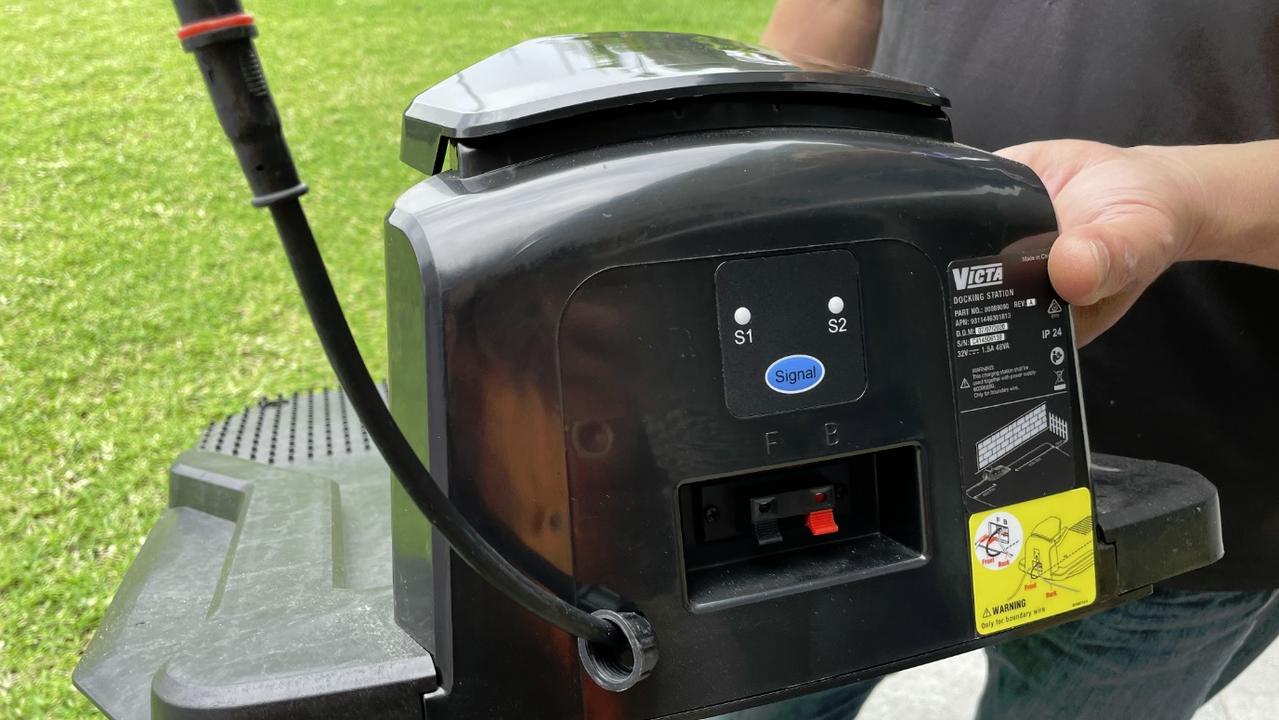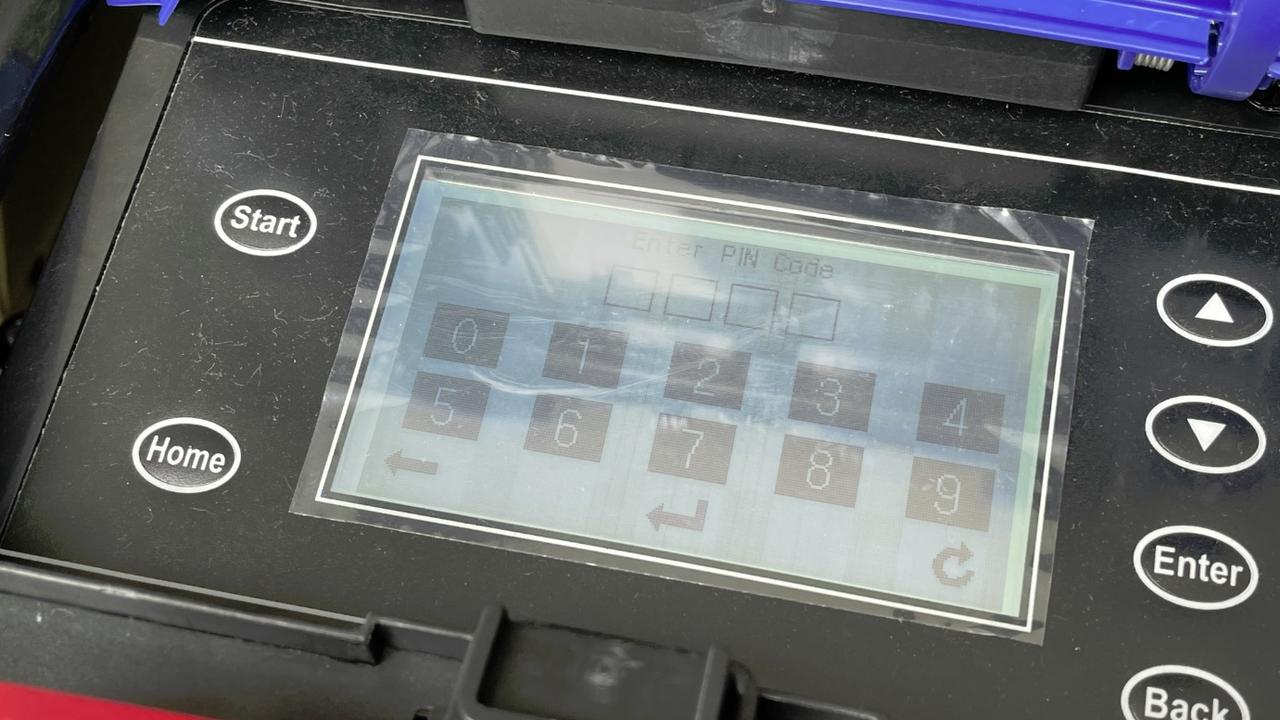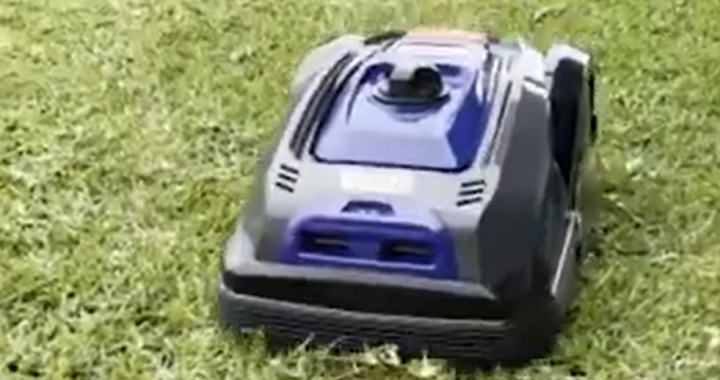I had an uncomfortable feeling, watching a battery-powered robot Victa mow the lawns. I felt I should be out there mowing myself, trudging up and down the lawn row-after-row as I did as a kid in the 60s.
My concern was around deserving the ritualistic beer at the end, something regarded as “a human right” among legions of Australian suburban mower pushers over decades. There were drinks and cakes to share after mowing stints at home.
You now have to resign yourself to putting your feet up and enjoying a beer while watching the Victa RM100 do the hard yards. Life is tough.
To some, the idea of a runaway robot lawnmower with fast rotating blades has the makings of a great horror movie. However Victa‘s new RM100 robotic lawn won’t mow you down, it seems as safe as houses. Last week I watched this marvel go through its paces nearby Victa’s big new warehouse at Kemps Creek, west of Sydney.
The RM100 is Victa’s first robot mower and while nowadays it is owned by American firm Briggs & Stratton, it says some mowers are still assembled in Australia.
The robot system consists of the mower, a dock that recharges it, and you get 120 metres of perimeter wire that you lay permanently in the ground. You can buy more if need be. There’s a supply of pegs that you lay down 80 centimetres apart, 40 centimetres from the lawn’s edge.
READ MORE: The Victa mower gets a 21st century upgrade | Is the Mate X the Tesla of e-bikes? | Apple unveils iPhone 12 with 5G | HomePod mini is more than music | Sony’s tempting TV offer
You lay the wire deep so that grass quickly grows over it. The wire can even be slightly buried. It becomes inconspicuous and you won’t trip over it. The perimeter transmits a magnetic pulse that gives the mower its bearings. It will stop if there’s no pulse.
The mower has a sensor so it will seek to get around obstacles, but if you want to prevent it accidentally mowing, say, your prized flower bed, you can lay down more wire and pegs.

Briggs & Stratton category manager Joel Hawkins says Victa’s approach to robot grass cutting is different to traditional mowing. You first cut long grass with a conventional mower so that it isn’t too high. The robot mower then takes over, cutting the grass every couple of days to keep the desired length so that it always looking manicured. Over time you can bring the height adjustment down so that the cut is short.
The mower has a console for configuring the days and times of the week that mowing occurs. You might opt for mowing every second day in spring, and a lower frequency in winter.
You can choose whether the robot mower will trim at the boundary, and the distance it runs over it. You can choose between two different magnetic pulse systems in case your next door neighbour coincidentally has an RM100 with the same perimeter signalling.
I watched as the mower made its way off the charger and whirred into action. It first travelled along the perimeter, cutting as it went. It then started mowing the area generally. The RM100 is quiet enough to schedule runs at night without it worrying neighbours. Occasionally you hear a crunching, grinding noise though.
It doesn’t mow in adjacent strips as we humans do. When it gets to the perimeter line, it rotates a random amount, and heads forward. It’s the system that some early robotic vacuums used. Over time the RM100 will cover all areas. Our test strip was level but Mr Hawkins says the mower handles slopes of up to 21 degrees.
The RM100 doesn’t have a grass catcher. Victa says that with regular mowing you hardly notice the cuttings which are left as mulch.
The robot mower has several safety features. First, the mower won‘t run away. It will only operate inside its perimeter, and if the wire loses power, the mower stops. Mowing switches off if you manually move it or turn it over.

Mr Hawkins says the blades are small and it’s hard for an animal to get its paws underneath. “That’s really pretty much impossible,” he says.
The mower has a rain sensor, so if it detects a shower, it heads back to the docking station.
If you buy an RM100 either from the company’s authorised agencies or Bunnings Online, you can recoup a small kennel-style cover that fits over the charging dock, that will keep the RM100 out of the weather, although Victa says it is weatherproof and waterproof.
But can an envious neighbour pinch it? Victa says it has an antitheft alarm that sounds if someone carries it outside the perimeter. I didn’t hear how loud it is. In any case, you need to key in a PIN to get it going. Even if a neighbour pinches it, they’ll have problems using it.
Victa says the robot mower is best suited to lawns between 200 and 600 square metres. The company provides a long power cord for connecting your mains power to the dock. Depending on your set-up you might have an electrician install a permanent line beneath the ground to nearby the dock, in the way people install power points in entertainment areas.
If you have separate front and back lawns, you’ll need to set up separate perimeter areas and move the mower between them. Within a 600 metre area, you can establish up to four subzones and key in days and times for mowing each.
I watched the robot mower make its way back and forth over this grassed area. When the power level gets low, it returns to the perimeter wire and follows it back to the dock for automatic recharging. This worked well.

The RM100 is at an early stage in the evolution of the robot mower. Victa agrees there is scope for much more, like using a sensor to know its location, as a modern robot vacuum cleaner does. Perimeters could be set virtually rather than needing a physical wire.
Settings in future could be made via a Bluetooth connected phone app. You might command your digital personal assistant to start cutting. You could sit on your couch and say: “Alexa, do the mowing,” as you turn pages reading a magazine.
Victa is late to the party with this; China’s WORX, Sweden’s Husqvarna and Germany’s Gardena now owned by Husqvarna are three of many that have advanced robot mowers in the market. Yet the old Aussie favourite’s brand name will matter to many. But Victa needs to get going on innovation to be really competitive.
The RM100 is for consumers rather than commercial use; Victa might make a much larger industrial version in future.
It seems people are going battery-powered in the garden. Mr Hawkins says the sale of battery-powered leaf blowers – including a powerful 82 Volt one – and battery-powered trimmers have taken off in the past two years. They are still noisy, but not as noisy as petrol ones that have prompted anti-leaf blower movements in some countries.
The company’s battery-powered push mower also is proving popular, starting at $349.
The Victa Robot Mower RM100 sells for $1299 from Victa Gold dealers and Bunnings online.

Published in The Australian
